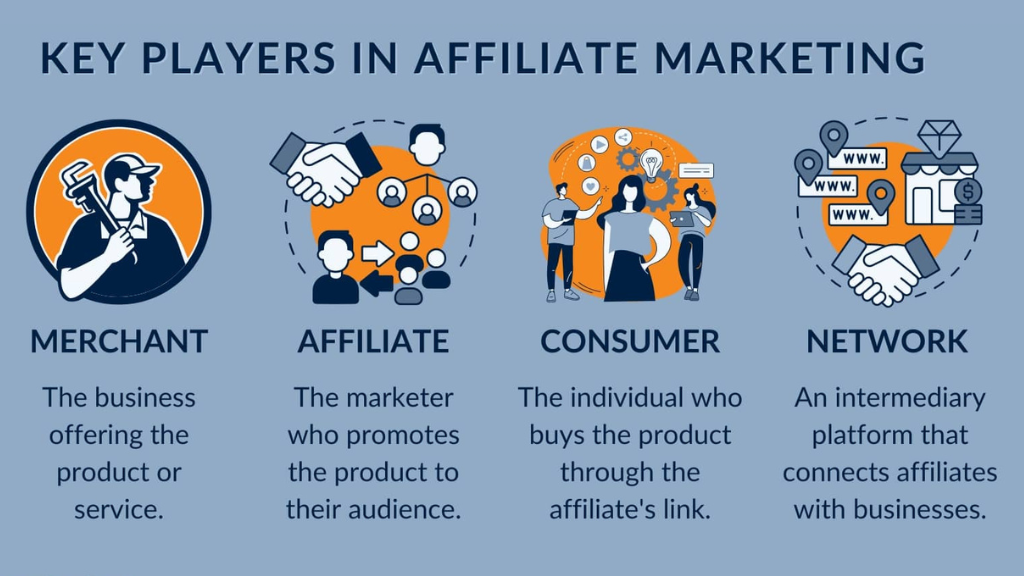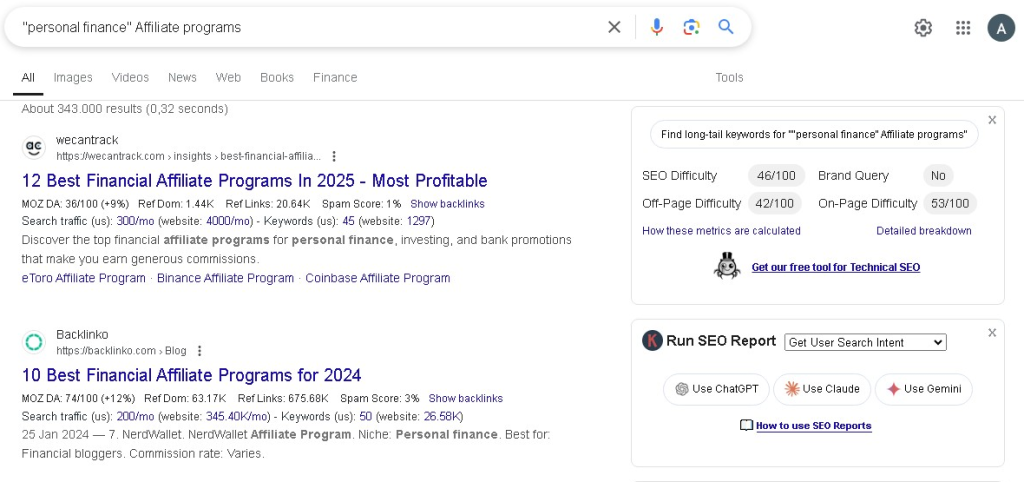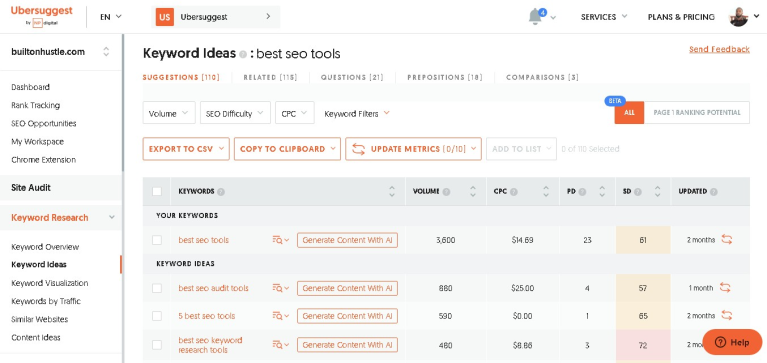Starting an affiliate blog is one of the proven ways to earn money online, even for beginners.
If you’ve ever wondered, “What is affiliate blogging?” or felt overwhelmed by the idea of starting your own affiliate blog, you’re not alone. The good news? It’s a lot simpler than it sounds.
You only need to start a blog, share helpful content with your audience, and get paid whenever someone makes a purchase through your affiliate links.
In this guide, we’ll break everything down for you. From how affiliate blogging works to practical tips for beginners looking to dive in. By the time you’re done reading, you’ll have all the tools you need to start your own affiliate blog and earn your first commission.
Let’s get started.
What is Affiliate Blogging?
Affiliate blogging is a type of blogging where you promote products or services through affiliate links on your blog. When a reader clicks on your link and completes an action, you earn a commission.
Essentially, you act as the bridge between the customer and the product. You help brands gain visibility while earning money for yourself.
Unlike traditional blogging, which might rely solely on ad revenue or sponsorships, affiliate blogging ties your income directly to your readers’ engagement and purchasing decisions.
This performance-based model is what makes it so appealing—and challenging.
For example, if you’re passionate about health and wellness, you might write a blog post about the best fitness gadgets. Within that post, you’d include affiliate links to the products you’re recommending.
If your readers trust your advice and decide to buy, you’ll earn a percentage of the sale. And if they don’t trust your advice… Well, just pray they do!
How Affiliate Blogging Works
Affiliate blogging revolves around three key players:
- The Merchant (Brand): This is the company offering a product or service. They create affiliate programs to incentivize bloggers and marketers to promote their products.
- The Affiliate (You): As the affiliate, your job is to promote the merchant’s products through content like blog posts, reviews, and tutorials.
- The Consumer (Your Audience): These are your blog readers who click on your affiliate links and (hopefully) convert into paying customers.
Sometimes, it can also involve the fourth player; an Affiliate network, where publishers are connected with multiple brands In one platform.

Essentially, here’s how the process unfolds:
- You join an affiliate program (e.g., Amazon Associates, JVZoo, or Impact Radius).
- You receive unique tracking links for the products you want to promote.
- You write blog posts, include those affiliate links, and drive traffic to your site.
- When a reader clicks on your link and completes an action, you earn a commission.
Affiliate programs use cookies to track conversions, ensuring you get credit for referrals even if the purchase isn’t immediate.
For different programs, the cookie duration varies. Some programs offer up to 90-day cookies while others offer just 24hrs cookies.
How to Start Affiliate Blogging
Becoming an affiliate for a brand is super easy and anyone can join a program and get a referral link. But as for blogging? Well, It takes strategy, consistency, and a good dose of patience.
To start affiliate blogging, there are steps and procedures to follow.
1. Choosing a Niche
The compulsory first step to take while trying to start a blog for affiliate marketing is choosing a profitable niche.
Your niche is the foundation of your blog. It’s what you’ll write about and the audience you’ll target. The most successful affiliate bloggers focus on niches they’re passionate about, but also ones with profitable opportunities.
While I am going to stand here and choose a niche for you, I can give you ideas on how to find the best niche based on your interests and market demand.
Affiliate blogging is about helping others solve a problem. So, start with examining your capabilities. What problem can you passionately solve?
Use platforms like Quora and Reddit to find out what problems people are facing, and check if you can be of help in any way.
If there’s any problem you can solve, then you are already ahead of others. Next, you should check if there are products you can recommend to solve these problems.
To find products, conduct a quick search on Google using “Keyword” + Affiliate program. For example, if you choose the personal finance niche, you could search [“personal finance” Affiliate programs].

This search will show results containing different affiliate programs for your niche. If no affiliate program is found for your niche, it means you should change focus. A great niche strikes a balance between your interests and market demand.
2. Setting Up Your Blog
Starting a blog is easier than ever with Hostinger + WordPress. basically, it takes less than 5 minutes to set up a blog on this platform.
What you will need are:
- Domain name
- Hosting space
- Affiliate marketing theme
A domain name is your blog address on the internet. something like “yourdomain.com”. This is what your audience will type into their address bar whenever they want to access your blog.
Domain names cost around $14 per year, but if you buy a hosting space from Hstinger, you will get a one-year free domain.
A hosting space (webserver) is a server that hosts your blog files and makes them accessible remotely. It serves as the home of your blog while the domain serves as the address to this home.
The final thing you will need is an affiliate-ready WordPress theme. The most popular, and most robust theme is the Rehub theme by Sizam.
Read: How to Start a Blog: The Ultimate Beginner’s Guide
Once your blog is live, write your “About” page to introduce yourself and your blog’s purpose.
3. Finding Affiliate Programs
Choosing the right affiliate programs is a critical step in your affiliate blogging journey because they are the bridge between you and the products you promote.
So, it’s important to find options that align with your niche, audience, and income goals.
For beginners, Amazon Associates is a great starting point. It’s one of the largest and most accessible affiliate programs, offering commissions on a vast range of physical products.
However, the commission rates are relatively low (typically 1-10%), so this program works best if your blog generates high traffic.
For digital products and courses, JVZoo is a solid choice. It specializes in software, online courses, and other digital goods, often with commission rates ranging from 20% to 75%.
Another excellent option for affiliate blogs is Impact Radius. Known for its user-friendly interface and beginner-friendly approach, this network hosts thousands of reputable brands in diverse niches, from fashion to finance.
The platform also offers robust tracking tools to help you analyze your performance.
When selecting programs, focus on ones with fair commission rates, reliable payment structures, and products that genuinely resonate with your target audience.
4. Creating Quality Content
So you have your blog up and running, and you’re finally ready to start making money with affiliate blogging. What your blog needs at this stage is high-quality content.
Content truly is king in affiliate blogging, and it’s what separates successful bloggers from the rest. It is a way of building trust, showcasing expertise, and helping your audience solve problems.
And trust me, It is the only thing that attracts visitors to your blog.
But what content should you even put up there? an what format should you use?
Yes, there are types of blog posts that attract sales, and there are some that are purely informational, nothing more. So, to make your affiliate blogging work, focus on creating content that genuinely addresses your audience’s needs, and put them in the following formats:
- Product Reviews: Honest and in-depth product reviews are a staple of affiliate blogging. Readers want to know the pros and cons of a product before they make a purchase.
- Comparison Articles: Articles comparing two or more products (e.g., “Best Laptops for Students: MacBook vs. Surface Pro”) are highly effective. These posts help readers weigh their options, often leading them to make a decision through your affiliate link.
- Tutorials and How-To Guides: Content that teaches readers how to use a product or solve a problem using specific tools is incredibly valuable. For instance, if you’re in the tech niche, you could create a guide titled “How to Set Up a Home Office with These 5 Essential Gadgets.”
- Listicles: People love lists because they’re easy to scan and packed with useful information. Titles like “Top 10 Travel Accessories You Can’t Live Without” are great for grabbing attention and including multiple affiliate products.
No matter the format, always prioritize transparency. Disclose your affiliate relationships clearly and honestly, either at the top of the post or wherever you include links.
5. Promoting Your Blog
Traffic generation is the most important part of your affiliate blogging journey. If you aren’t promoting your blog effectively, you’re losing money.
Yes, because, Even the best content won’t generate income if no one sees it. So it’s critical to focus on strategies that drive consistent, high-quality traffic to your site.
Let’s break down different ways to promote your blog and drive traffic;
Search Engine Optimization (SEO):
SEO is one of the most powerful tools in an affiliate blogger’s arsenal. Once a blog post is indexed and ranked, it continues to drive free organic traffic for years.
Let’s say you optimize your blog posts for keywords like “how to start affiliate blogging” or “best travel gadgets for 2025,” you can increase your chances of ranking higher on Google, which accounts for 69% of affiliate traffic.
However, SEO is not a lazy man’s dance. It requires constant research, monitoring, optimization, link building strategies to beat the competition.
Start by conducting keyword research using free SEO tools like Ubersuggest to find search terms your target audience is using. Then, incorporate these keywords naturally into your titles, headings, meta descriptions, and content.
Social Media Marketing:
Social media platforms can be goldmines for affiliate bloggers. While you wait for Google and other search engines to pick up your blog and index every single post in it, spare some time to engage in active social media promotions.
Pinterest, in particular, is ideal for driving traffic to blog posts, as users often search for ideas, guides, and product recommendations.
You might need to create eye-catching graphics using tools like Canva to promote your blog posts on Pinterest, and optimize them for Pinterest SEO.
Instagram, on the other hand, is perfect for sharing engaging visuals and bite-sized product reviews, while TikTok allows you to create quick, entertaining videos about products.
The key is to post consistently and interact with your audience to build a loyal following.
Email Marketing:
Email marketing is often overlooked, but it’s one of the most effective ways to build relationships and promote affiliate products. In fact, the average ROI for email marketing ranges from $36 to $40 for every dollar spent.
Use tools like Systeme.io or Optin Monster to capture email leads through opt-in forms or freebies like eBooks or checklists.
Once you’ve built your list, send personalized recommendations and updates about new blog posts to keep your audience engaged.
With email, you can nurture trust, share value, and directly refer readers to affiliate products to increase your chances of earning commissions.
Tips for Success in Affiliate Blogging
Affiliate blogging can be incredibly rewarding, but success doesn’t come by chance. It’s the result of building trust with your audience, implementing smart strategies, and learning from your mistakes along the way.
Let’s break down key tips to ensure you stay on the right path and maximize your potential.
Building an Audience
The foundation of successful affiliate blogging is trust. No cap. Your audience won’t click on your links or buy the products you recommend unless they believe in your credibility.
The best way to build that trust is by genuinely helping your readers and putting their needs first before anything else.
A smart move would be “by identifying your audience’s pain points and creating content that addresses those issues“.
For example, if you’re in the personal finance niche, you could write articles like, “How to Save $1,000 a Month on a Tight Budget.” Then, recommend affiliate products that align with your solutions, such as budgeting apps or online financial courses.
If you often pick their pain points and provide a solution, they are going to trust you.
Don’t be afraid to share personal stories, like times you’ve struggled with a problem and how a particular product or strategy helped you solve it. People connect with authenticity, and it’s that connection that encourages them to trust your recommendations.
SEO Strategies for Affiliate Blogs
Search engine optimization (SEO) should be your #1 source of driving free, sustainable traffic to your blog.
But you can’t learn SEO over night. It takes consistent practice to master.
Start by researching keywords using tools like Ubersuggest, Ahrefs, or SEMrush.
Plug in a keyword related to the product you are promoting, and ubersuggest will reveal every other keywords you could rank for.

Once you’ve identified your target keywords, incorporate them naturally into your blog titles, headers, and body text.
But wait… SEO isn’t just about keywords. You also need to create high-quality, engaging content.
Write in-depth articles that provide value, answer questions, and keep readers on your page longer. Focus on internal linking by connecting related posts on your blog, and don’t forget to optimize your images with alt text to boost your search engine rankings.
Avoiding Common Mistakes
Many beginners in affiliate blogging make the mistake of chasing quick commissions by promoting low-quality products.
This not only damages your credibility but also alienates your audience. Instead, focus on promoting products you’ve tried yourself or thoroughly researched. If you wouldn’t recommend a product to a close friend, don’t recommend it to your readers.
Another common pitfall is overloading your content with affiliate links. This can come off as pushy and spammy.
FAQs About Affiliate Blogging
What is the difference between affiliate blogging and regular blogging?
Affiliate blogging focuses on earning commissions by promoting products, while regular blogging may rely on ad revenue or sponsorships.
How much can a beginner earn from affiliate blogging?
Beginners can earn anywhere from $100 to $1,000 per month, depending on their niche, traffic, and strategy.
Do I need technical skills to start affiliate blogging?
Not at all! Platforms like WordPress make it easy to set up a blog without technical expertise.
What are the best affiliate programs for beginners?
Amazon Associates, Impact Radius, and JVZoo are great options for beginners.
How long does it take to see results in affiliate blogging?
It depends on your effort and consistency. Most bloggers see noticeable results within 6–12 months.
Wrapping it up…
Affiliate blogging isn’t a get-rich-quick scheme, but it’s a rewarding way to earn passive income. With the right strategies and a commitment to helping your audience, you can turn your blog into a profitable venture.
Ready to take the leap? Start your affiliate blogging journey today!







